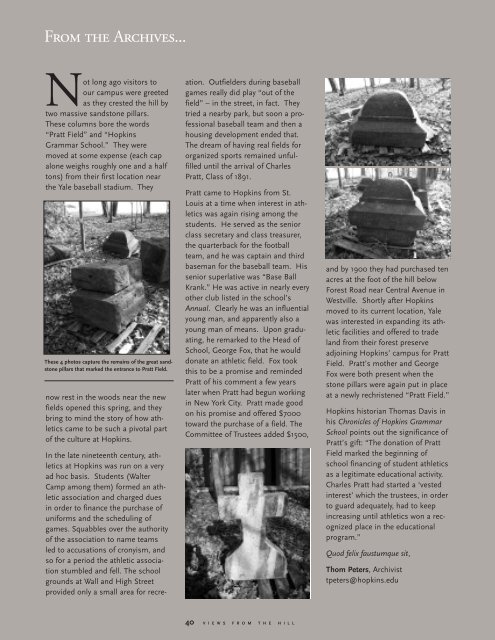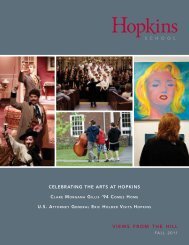For Love of the Game An Appreciation of Tom Parr ... - Hopkins School
For Love of the Game An Appreciation of Tom Parr ... - Hopkins School
For Love of the Game An Appreciation of Tom Parr ... - Hopkins School
You also want an ePaper? Increase the reach of your titles
YUMPU automatically turns print PDFs into web optimized ePapers that Google loves.
From <strong>the</strong> Archives...<br />
Not long ago visitors to<br />
our campus were greeted<br />
as <strong>the</strong>y crested <strong>the</strong> hill by<br />
two massive sandstone pillars.<br />
These columns bore <strong>the</strong> words<br />
“Pratt Field” and “<strong>Hopkins</strong><br />
Grammar <strong>School</strong>.” They were<br />
moved at some expense (each cap<br />
alone weighs roughly one and a half<br />
tons) from <strong>the</strong>ir first location near<br />
<strong>the</strong> Yale baseball stadium. They<br />
These 4 photos capture <strong>the</strong> remains <strong>of</strong> <strong>the</strong> great sandstone<br />
pillars that marked <strong>the</strong> entrance to Pratt Field.<br />
now rest in <strong>the</strong> woods near <strong>the</strong> new<br />
fields opened this spring, and <strong>the</strong>y<br />
bring to mind <strong>the</strong> story <strong>of</strong> how athletics<br />
came to be such a pivotal part<br />
<strong>of</strong> <strong>the</strong> culture at <strong>Hopkins</strong>.<br />
In <strong>the</strong> late nineteenth century, athletics<br />
at <strong>Hopkins</strong> was run on a very<br />
ad hoc basis. Students (Walter<br />
Camp among <strong>the</strong>m) formed an athletic<br />
association and charged dues<br />
in order to finance <strong>the</strong> purchase <strong>of</strong><br />
uniforms and <strong>the</strong> scheduling <strong>of</strong><br />
games. Squabbles over <strong>the</strong> authority<br />
<strong>of</strong> <strong>the</strong> association to name teams<br />
led to accusations <strong>of</strong> cronyism, and<br />
so for a period <strong>the</strong> athletic association<br />
stumbled and fell. The school<br />
grounds at Wall and High Street<br />
provided only a small area for recre-<br />
ation. Outfielders during baseball<br />
games really did play “out <strong>of</strong> <strong>the</strong><br />
field” – in <strong>the</strong> street, in fact. They<br />
tried a nearby park, but soon a pr<strong>of</strong>essional<br />
baseball team and <strong>the</strong>n a<br />
housing development ended that.<br />
The dream <strong>of</strong> having real fields for<br />
organized sports remained unfulfilled<br />
until <strong>the</strong> arrival <strong>of</strong> Charles<br />
Pratt, Class <strong>of</strong> 1891.<br />
Pratt came to <strong>Hopkins</strong> from St.<br />
Louis at a time when interest in athletics<br />
was again rising among <strong>the</strong><br />
students. He served as <strong>the</strong> senior<br />
class secretary and class treasurer,<br />
<strong>the</strong> quarterback for <strong>the</strong> football<br />
team, and he was captain and third<br />
baseman for <strong>the</strong> baseball team. His<br />
senior superlative was “Base Ball<br />
Krank.” He was active in nearly every<br />
o<strong>the</strong>r club listed in <strong>the</strong> school’s<br />
<strong>An</strong>nual. Clearly he was an influential<br />
young man, and apparently also a<br />
young man <strong>of</strong> means. Upon graduating,<br />
he remarked to <strong>the</strong> Head <strong>of</strong><br />
<strong>School</strong>, George Fox, that he would<br />
donate an athletic field. Fox took<br />
this to be a promise and reminded<br />
Pratt <strong>of</strong> his comment a few years<br />
later when Pratt had begun working<br />
in New York City. Pratt made good<br />
on his promise and <strong>of</strong>fered $7000<br />
toward <strong>the</strong> purchase <strong>of</strong> a field. The<br />
Committee <strong>of</strong> Trustees added $1500,<br />
40 V I E W S F R O M T H E H I L L<br />
and by 1900 <strong>the</strong>y had purchased ten<br />
acres at <strong>the</strong> foot <strong>of</strong> <strong>the</strong> hill below<br />
<strong>For</strong>est Road near Central Avenue in<br />
Westville. Shortly after <strong>Hopkins</strong><br />
moved to its current location, Yale<br />
was interested in expanding its athletic<br />
facilities and <strong>of</strong>fered to trade<br />
land from <strong>the</strong>ir forest preserve<br />
adjoining <strong>Hopkins</strong>’ campus for Pratt<br />
Field. Pratt’s mo<strong>the</strong>r and George<br />
Fox were both present when <strong>the</strong><br />
stone pillars were again put in place<br />
at a newly rechristened “Pratt Field.”<br />
<strong>Hopkins</strong> historian Thomas Davis in<br />
his Chronicles <strong>of</strong> <strong>Hopkins</strong> Grammar<br />
<strong>School</strong> points out <strong>the</strong> significance <strong>of</strong><br />
Pratt’s gift: “The donation <strong>of</strong> Pratt<br />
Field marked <strong>the</strong> beginning <strong>of</strong><br />
school financing <strong>of</strong> student athletics<br />
as a legitimate educational activity.<br />
Charles Pratt had started a ‘vested<br />
interest’ which <strong>the</strong> trustees, in order<br />
to guard adequately, had to keep<br />
increasing until athletics won a recognized<br />
place in <strong>the</strong> educational<br />
program.”<br />
Quod felix faustumque sit,<br />
Thom Peters, Archivist<br />
tpeters@hopkins.edu





